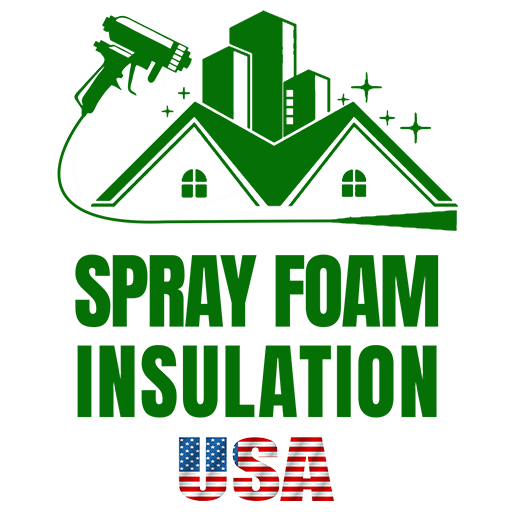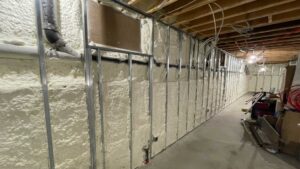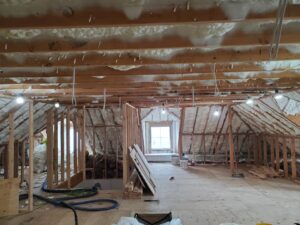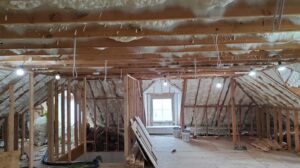Attic blow-in insulation is a smart choice for homeowners in NY and NJ looking to enhance their home’s energy efficiency and comfort. This type of insulation provides an effective barrier that keeps your home warm in winter and cool in summer, helping to reduce your energy bills significantly.
Blown-in insulation is particularly valued for its ability to fill hard-to-reach nooks and crannies in the attic, ensuring a thorough coverage that traditional batts can’t match. This comprehensive coverage not only helps in maintaining a consistent temperature throughout your home but also plays a crucial role in cutting down on your heating and cooling costs.
The utilization of recyclable materials like cellulose in blown-in insulation also appeals to those prioritizing environmental sustainability. Moreover, the installation process is generally quick and cost-effective, making it an attractive option for those looking to improve their home’s comfort without extensive renovation.

Choosing the Right Insulation Material
When upgrading your attic with blown-in insulation, selecting the right material is crucial for enhancing energy efficiency, ensuring cost-effectiveness, and minimizing environmental impact. The two most popular materials are cellulose and fiberglass. Let’s break down these options to help you make an informed choice.
Cellulose vs. Fiberglass
Cellulose:
– Eco-Friendly: Made from up to 85% recycled paper, primarily newspaper, treated with fire retardants. This makes it a sustainable choice for environmentally conscious homeowners.
– High R-Value: Offers about R-3.1 to R-3.8 per inch. This high resistance to heat flow means better thermal insulation, keeping your home warmer in winter and cooler in summer.
– Fire Resistance: Enhanced safety due to the addition of fire retardant chemicals.
Fiberglass:
– Cost-Effective: Generally less expensive than cellulose, providing a budget-friendly option without compromising on quality.
– Versatile R-Values: Offers R-values ranging from R-2.2 to R-4.3 per inch, depending on the installation density. This flexibility allows for customization based on specific needs.
– Moisture Resistant: Unlike cellulose, fiberglass is less prone to absorb moisture, making it suitable for more humid climates.
Understanding R-Value
The R-value is a measure of insulation’s ability to resist heat flow. The higher the R-value, the more effective the insulation. For attic insulation, a higher R-value is crucial, as it significantly impacts your home’s temperature regulation and energy efficiency. Depending on your climate, the recommended R-value for attic insulation usually ranges between R-30 and R-60.
Cost-effectiveness
While initial costs can be a concern, it’s important to consider long-term savings. Cellulose is typically more expensive than fiberglass but offers superior thermal insulation and eco-friendliness, which can translate into higher energy savings over time. On the other hand, fiberglass provides a more cost-effective upfront investment and is less susceptible to moisture-related issues, which could save on future maintenance costs.
Environmental Impact
Choosing insulation with a lower environmental impact is increasingly important. Cellulose scores high in this area due to its high recycled content and biodegradability. However, the energy savings from both cellulose and fiberglass also contribute to reduced greenhouse gas emissions, making both choices better for the environment than traditional insulation materials.
By considering these factors—material type, R-value, cost-effectiveness, and environmental impact—you can make a well-informed decision that meets your specific needs and preferences for attic blow in insulation. This decision not only impacts the comfort and efficiency of your home but also plays a part in your broader environmental footprint.
The Benefits of Blown-In Insulation
When you’re considering attic blow in insulation, understand the full range of benefits it offers. This type of insulation is not just about filling up space in your attic; it’s about enhancing your home’s overall performance and comfort. Let’s break down these advantages:
Thermal Insulation
Blown-in insulation is excellent for keeping your home warm in the winter and cool in the summer. It works by creating a dense barrier that traps air and slows the transfer of heat. This means your heating and cooling systems don’t have to work as hard, which can lead to significant energy savings. In fact, some homeowners have reported cutting their energy bills by over half during colder months.
Eco-friendly
One of the standout features of blown-in insulation, particularly cellulose type, is its eco-friendliness. Cellulose insulation is made from up to 85% recycled paper, primarily newspapers, making it one of the most sustainable choices available. This high recycled content not only reduces waste in landfills but also uses less energy in manufacturing compared to other insulation materials.
Coverage
The ability of blown-in insulation to fill in gaps, corners, and crevices is unmatched. This comprehensive coverage ensures there are no air leaks or missed spots, which are common issues in batt insulation. Properly installed, it forms a seamless thermal blanket over your attic. This thorough coverage is crucial in minimizing heat loss and ensuring consistent temperatures throughout your home, enhancing comfort.
Energy Efficiency
Blown-in insulation’s ability to seal your home against air leaks and its high thermal resistance translates directly into energy efficiency. By maintaining more consistent indoor temperatures, it reduces the strain on your HVAC system. This not only lowers your energy bills but also extends the lifespan of your heating and cooling systems due to less frequent cycling.
By understanding these benefits, you can see how attic blow in insulation is not just an expense but an investment in the comfort, sustainability, and efficiency of your home. With its superior coverage, eco-friendly materials, and significant impact on energy savings, blown-in insulation stands out as a smart choice for homeowners looking to enhance their living environment and reduce their ecological footprint.
How to Install Blown-In Insulation in Your Attic
Installing attic blow in insulation is a practical way to enhance your home’s energy efficiency and comfort. This section will guide you through the necessary steps, from preparation to achieving the desired R-value. Following these steps carefully ensures a successful insulation project.
Preparation
Before you begin, it’s crucial to prepare your attic for insulation:
- Clear the Attic: Remove any stored items to create a clean and accessible workspace.
- Inspect and Repair: Look for any signs of damage, such as leaks or holes in the roof, and repair these issues to prevent future problems.
- Ventilation: Ensure your attic has proper ventilation to avoid moisture accumulation that can lead to mold growth.
Sealing Air Leaks
Air leaks can undermine the effectiveness of your insulation by allowing warm or cool air to escape:
- Find Leaks: Common areas include around light fixtures, electrical wires, and plumbing vents.
- Seal Leaks: Use caulk for smaller gaps and expanding foam for larger openings. Make sure to also check and seal around the attic hatch.
Using Blowing Equipment
Blown-in insulation requires specific equipment, generally available for rent at home improvement stores:
- Rent the Equipment: Choose a blower that is compatible with the type of insulation you are using—cellulose or fiberglass.
- Setup: Follow the manufacturer’s instructions to set up the blower. It usually involves attaching a hose and filling the machine with insulation.
Achieving Desired R-value
The R-value you aim for depends on your climate and the existing insulation, if any:
- Determine R-value: Refer to local building codes or an energy advisor to find out the recommended R-value for your area.
- Apply Evenly: Start at the farthest point from the attic hatch and work backward toward the entrance. This method ensures even coverage and prevents you from compacting the insulation as you move.
By following these steps, you can effectively install blown-in insulation in your attic, enhancing your home’s energy efficiency and comfort. Proper installation is key to maximizing the benefits of your insulation.
Common Mistakes to Avoid
When installing attic blow in insulation, it’s crucial to sidestep some common pitfalls that could undermine the effectiveness of your insulation and potentially lead to bigger issues down the line. Here are essential mistakes to avoid:
Over-Insulation
Adding too much insulation can be just as problematic as having too little. Over-insulating can lead to:
– Increased moisture: Too much insulation can trap moisture, leading to mold and mildew problems.
– Wasted materials and money: You’re spending more on insulation than necessary, without additional energy savings.
– Structural issues: Excessive weight from too much insulation might stress your attic’s structure.
How to Avoid:
– Check the recommended R-value for your area and ensure you do not exceed these guidelines.
Ignoring Ventilation
Your attic needs proper airflow to prevent moisture accumulation and maintain a balanced temperature. Blocking air flow can lead to:
– Moisture problems: Without ventilation, condensation can accumulate, leading to mold and wood rot.
– Reduced insulation efficiency: Moisture can degrade the insulation’s effectiveness.
How to Avoid:
– Ensure that soffit vents are not covered by insulation.
– Consider installing baffles to maintain clear air paths.
Uneven Distribution
Unevenly distributed insulation can lead to hot and cold spots in your home, reducing the overall efficiency of your insulation.
How to Avoid:
– Use a consistent method when blowing in the insulation, ensuring it spreads evenly across the entire attic.
– Regularly check the depth and spread of the insulation during the application process.
Skipping Safety Gear
The materials used in blown-in insulation can be harmful if inhaled or if they come into contact with your skin.
How to Avoid:
– Always wear protective gear, including gloves, goggles, a dust mask, and a long-sleeved shirt.
– Ensure the attic is well-ventilated during the installation process to minimize inhalation of dust.
By avoiding these common mistakes, you can ensure that your attic blow in insulation is as effective and safe as possible. Proper installation not only maximizes energy efficiency but also extends the life of your insulation and maintains the structural integrity of your home. A little extra care during the installation process can lead to significant benefits in comfort and cost savings over time.
Frequently Asked Questions about Attic Blow-In Insulation
Is blown-in attic insulation worth it?
Blown-in attic insulation is highly cost-effective and can lead to long-term savings on your energy bills. Many homeowners find that their heating and cooling costs drop significantly after installation. For example, one homeowner reported a reduction of over half in their heating bill during winter after opting for blown-in insulation. Additionally, it’s an eco-friendly decision; materials like cellulose are often made from recycled paper, making them a sustainable choice that contributes to reducing waste.
What is the best insulation to blow in attic?
When considering cellulose vs. fiberglass for blown-in attic insulation, cellulose often stands out, especially in terms of environmental impact and thermal efficiency. Cellulose has a higher R-value per inch compared to many types of fiberglass, providing better thermal resistance. This makes it particularly effective at keeping your home warm in winter and cool in summer, enhancing overall energy efficiency.
Can you put too much blown insulation in your attic?
Yes, there are risks of over-insulation. Adding too much insulation can lead to issues like moisture problems and reduced effectiveness of the insulation itself. It’s crucial to follow optimal R-value guidance, which varies based on your geographical location and the specific needs of your home. Over-insulating not only wastes materials and money but can also complicate maintenance and repairs in your attic space.
By considering these factors, you can make informed decisions about your attic insulation that will provide comfort, efficiency, and sustainability. Proper installation and choosing the right material are key to maximizing the benefits of your insulation.
Conclusion
In wrapping up our discussion on attic blow in insulation, it’s evident that the key to reaping the full benefits of this insulation method lies in professional installation. At Spray Foam Insulation USA, we understand the intricacies involved in ensuring that every nook and cranny of your attic is effectively covered.
Why Opt for Professional Installation?
-
Expertise and Precision: Our team is trained to handle the complexities of attic insulation. They know exactly how much material is needed and how to distribute it evenly to avoid any gaps or over-insulation issues.
-
Safety: Insulation involves materials that can be irritable to the skin and lungs. Our professionals are equipped with the right safety gear and know how to handle these materials safely.
-
Time-Saving: Instead of spending your weekend renting equipment and trying to figure out the process, our team can complete the job efficiently, saving you time and hassle.
-
Long-Term Savings: Although DIY might seem cheaper upfront, incorrect installation can lead to energy losses. Professional installation ensures that your insulation is as energy-efficient as possible, saving you money on heating and cooling costs in the long run.
At Spray Foam Insulation USA, we don’t just install insulation; we ensure that it contributes to the energy efficiency and comfort of your home. Our approach is to provide tailored solutions that meet the specific needs of your home, enhancing its overall energy performance and comfort.
Contact Us Today
Ready to enhance your home’s energy efficiency with professional attic blow in insulation? Contact Spray Foam Insulation USA today for a free estimate. Let’s work together to make your home comfortable and energy-efficient, season after season.





